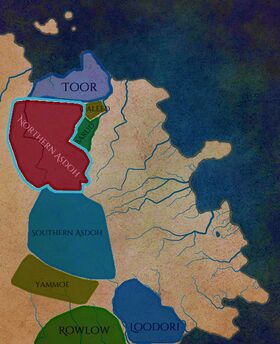State of Asdoh
| Asdoh | |
| Political details | |
|---|---|
| Capital | Estonoh |
| Government | monarchy |
| Language | Asdoh |
| Religion | Xaewoon |
| Historical details | |
| Established | 16th CFR |
| Disestablished | 180s SR |
Asdoh /'yɑsdə/ was the first documented Tarnarian state of the Dawn settlers.
With the mission of creating an Eastern Dantrian civilization, as a counterpart to Western Dantria, it re-created elements of the Western Dantrian culture, such as architecture and government, with the goal of expanding its influence and control over the whole of Tarnaria.
Reaching its peak at the end of the first revolution, Asdoh's influence began to decline soon after that. Asdoh was eventually abolished by Stogen in the 2nd CSR and broken down into individual city states, most of which have been then deserted. Ernele is the only surviving city of Asdoh, retaining some of the ancient buildings.
Asdoh's sophisticated governance, economics, Western Dantrian cultural heritage and the fact that so much of its brilliance was lost, turned it into a legendary country, highly mythologized and revered by many as the greatest Tarnarian civilization. The emergence of the Mōroh philosophy in the 2nd CSR had treated Asdoh as the biggest religious mistake of the peoples of Tarnaria, condemning the sedentary form of life, which was understood as the refusal to follow one's path.
The Asdoh vs Mōroh debate is still prevalent in Tarnaria and is an ideological divide between some groups.
History
Ideology
Ideology played a major role in Asdoh. It viewed itself as a progenitor of Western Dantria and together with Yammoe competed for the dominant role in the east.
Bontyloh Romonoh was one of the earliest kings of Asdoh and authored a number of scrolls which outlined the vision for a new world. It included Asdoh as the "head of the new land: its teacher, parent and guiding light".
As a result of this decree, Asdoh built its power and influence on the advanced knowledge and technology that was exported from Dantria. Unlike many of the Dawn pioneers, Asdohns retained a lot of the Dantrian knowledge. Asdon architects, engineers and philosophers were available for hire by other states in Tarnaria, but the sharing of knowledge was strictly prohibited, which even led to a number of specialists being kidnapped. This, in turn, prompted Asdoh to have its experts be accompanied by troops. The famous architect of his day, Myloh Fosod, who built the famous palace in Nadd, was said to have arrived to the construction with a whole army.
Economy
Transportation and communication
Asdoh was notable for building wide and flat roads out of red stone, known as "red roads". This technology is believed to have originated in Western Dantria. It was largely lost after the dissolution of the State of Asdoh, although the Empire of Barud used a similar technique. It was equally lost when Barud was overrun by Stogen in the 2nd CSR.
These roads allowed for much faster travel and communication, which also led to a wider distribution of cities and settlements, since it was possible to reach larger cities and water supplies from farther away.
Trade and commodities
Asdoh exported a number of highly valued commodities, most notably its papers: hemp paper, banana paper and silk paper. Grains and fruit were other major commodities, including banana and tomatoes.
Architecture and engineering
Asdoh was a major soft power in the first revolution, with Asdohn scholars, architects and artisans being in high demand. Almost every major palace in Tarnaria before 2 SR had been built by Asdohn architects.
Politics
Asdoh was a monarchy that was somewhat reminiscent of a system later seen in Leykarya and generally believed to have originated from Dantria.
The land was ruled by several royal families, the representative of only one of which would be the actual gole (king) at a given time. A complex system determined who would be the next gole.
The composition of the royal house, as well as the system of nobles was the basis of what became Hogloh vy Aanua, a ranks system widely used in Tarnaria throughout the first and second centuries, until gradually replaced by the assemblic monarchy.
